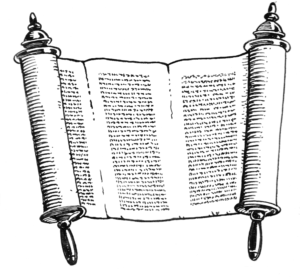Articles
Parshas Re’eh
August 26, 2022

For the love of kedushah
The parshah includes the warning to avoid erasure of the Name of Hashem (see Rashi, Devarim 12:4).
Rav Nachum Weidenfeld, rav of Dombrov, was presented with a painful halachic question by a man who was about to be hospitalized for treatment of a highly contagious infectious disease. He hoped to recover but was well aware that when he was released from the hospital, the medical staff would confiscate and burn all the belongings he had brought with him, to prevent spread of the microbe. His question was, should he bring his tefillin along so that he could put them on during his hospital stay, even though they would be burned at the end?
In a lengthy teshuvah, Rav Weidenfeld advised that he should not.
Several years later, in Elul of 1939, Rav Weidenfeld fled Dombrov in the face of the oncoming Nazi onslaught. He shipped his writings to a relative for safekeeping and took only his tefillin as he attempted to sneak into Soviet territory. The rav was caught at the border, and German patrols took his tefillin and threw them on the floor. He picked them up and covered them with kisses. The scene repeated itself three times until the Nazis forced him, at gunpoint, to leave the tefillin behind. Anguished, Rav Weidenfeld continued on but fainted at the first home at which he stopped and died of a broken heart.
After the war, his brother Rav Dov Berish Weidenfeld was once discussing his psak regarding tefillin in the hospital with another posek, who ruled differently. “If you knew how my brother died,” R’ Dov Berish said, “you wouldn’t argue with his psak!”
Today’s pillars of the world
The Torah tells us to take care of the kohanim and levi’im, particularly on Yom Tov.
In his discussion regarding whether this mitzvah applies today, the Binyan Shlomo explains that this mitzvah very nearly restores the Beis Hamikdash to us. By financially supporting Shevet Levi, we make sure that all the pillars of the world—Torah, avodah, and chessed—are firm.
The levi’im and kohanim needed support because they could not work the fields; they were too busy doing avodah during their shift or teaching Torah to the klal at other times. By supporting them—doing chessed—we ensured that Torah and avodah could continue, through chessed. These are the central aspects of the Beis Hamikdash.
Today, we may not have levi’im and kohanim at their avodah, but we do have a unique class of people that give up their livelihood to become great in Torah and to be able to teach others. These are the rabbanim and roshei yeshivah, and through our support, we can still ensure that the three pillars of the universe are firm.
The hidden command: Sinai or Marah?
About three mitzvos, the Torah does not explain much. Regarding Shabbos, kibbud av, and shechitah, the Torah merely says to do “as I have commanded you,” without much detail. The Gemara (Chullin 28a) explains that the laws of shechitah were given orally at Sinai, while Shabbos and kibbud av were given at Marah (Sanhedrin 56b).
Why the difference? And how do we know all three were not given at either Marah or Sinai?
The Taz explains that, all things being equal, any reference to a previous command likely refers to Sinai. But Shabbos and kibbud av were mentioned explicitly in the Aseres Hadibros at Sinai, so a previous command must have been given earlier—at Marah.
Rav Yonasan Eibeshutz explains, on the other hand, that according to Rabi Akiva, the mitzvah of shechitah did not begin until Klal Yisrael entered Eretz Yisrael (Chullin 17a). Accordingly, it is unlikely to have been explained all the way back at Marah.
The soaring broken spirit
When telling us to follow in Hashem’s ways, the Torah uses the word “acharei,” meaning, “follow ‘after’ Hashem.” The difference between “achar” and “acharei” is that the former implies following closely, while the latter means trailing a distance behind. Why does the Torah not use the word “achar,” which would mean we should follow Hashem closely?
When he greeted the Imrei Emes at the first Knessiah Gedolah, the Chafetz Chaim raised this question. He answered: The Torah is teaching that even when a person feels distant from Hashem, chalilah, when they are gripped by depression and despair, they should stick to Him. The hopelessness is just a tactic of the yetzer hara, looking to drive a wedge between us and our Father.
The Imrei Emes responded with what he called a “chassidic twist”: particularly in those broken moments, a person is closest to Hashem, for He is closest with those of broken spirit.
The cherry tree told the story
When the king of Prague wanted cherries in the middle of the winter, he couldn’t get any. All his importers and farmers failed to find cherries. In desperation, the king turned to the Maharal. The Jewish rabbi advised the king’s horticulturists to pour a mixture of cooked meat and milk on the roots of the royal cherry trees. Sure enough, after repeating the procedure a number of times, the trees blossomed and bore fruit, providing the king with his precious cherries.
One of the servants patented the technique, taking credit for it himself, and it spread throughout the land in his name. Many years later, Rav Yonasan Eibeschutz heard about it and correctly identified it as having a Jewish source. This is the meaning of the pasuk that combines the issur to cook or eat meat and milk with the mitzvah of bikkurim, R’ Yonasan explained. The Torah is warning us not to use meat cooked in milk to hasten the mitzvah of bikkurim. Although the milk-meat potion can produce early fruits, which might make a true zariz want to use it to get those first fruits out earlier so he can bring bikkurim earlier, the Torah says that the issur to cook meat in milk remains in force.